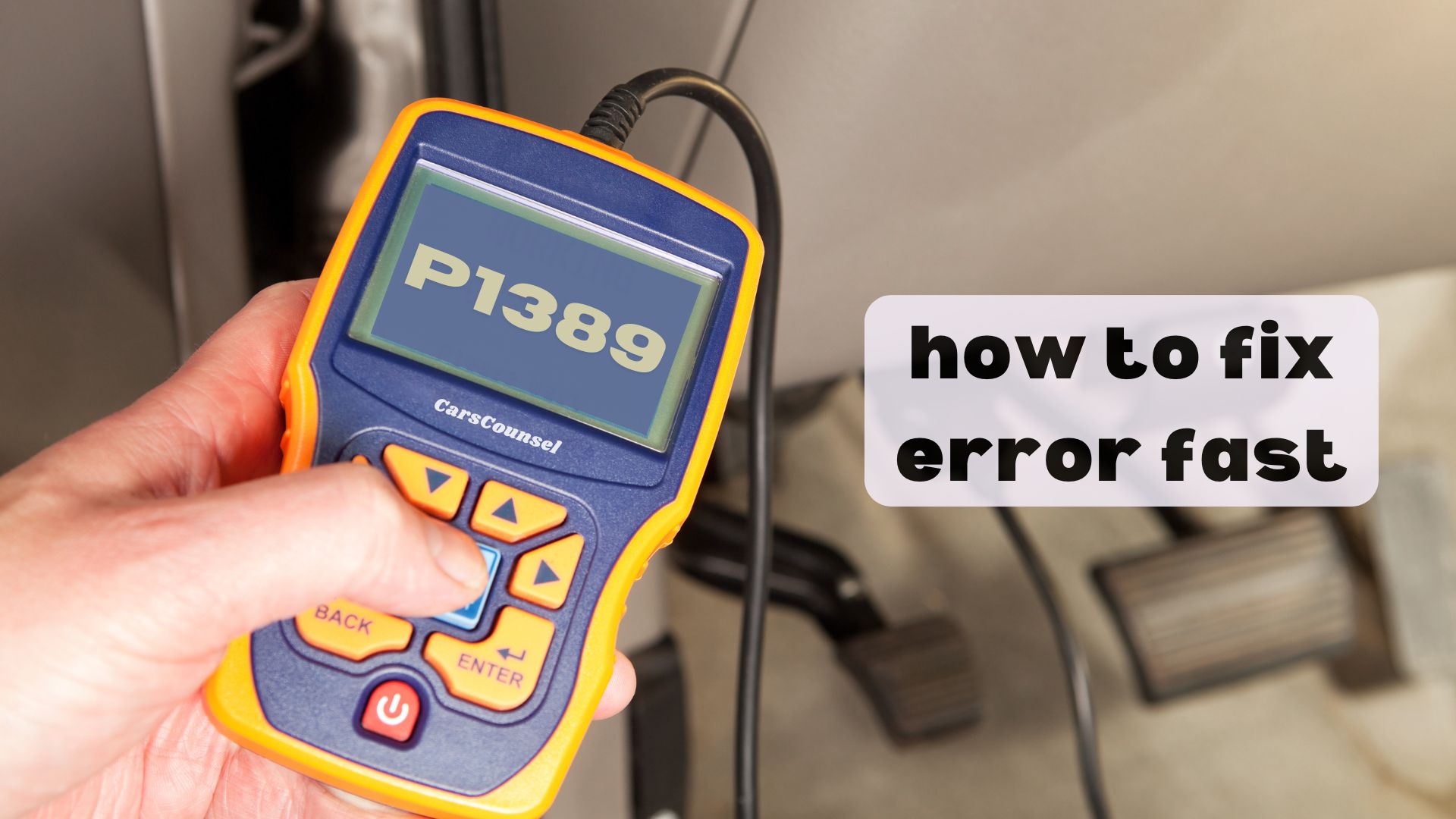Imagine your car’s engine refusing to shut down, still humming away even after you’ve turned the key off – it’s a unsettling feeling, to say the least. This scenario can become a reality if your Powertrain Control Module (PCM) detects no voltage from the auto shutdown relay, triggering the P1389 code. This code is a warning sign that something’s amiss, and you’ll want to investigate further to prevent potential safety risks and costly repairs down the line. What’s causing this malfunction, and how can you fix it?

Quick Navigation
Key Takeaways
- The P1389 code is triggered when the Powertrain Control Module (PCM) detects no voltage from the auto shutdown relay.
- The auto shutdown relay is responsible for cutting off power to the fuel pump and ignition system in emergency situations or when the engine is turned off.
- Common causes of the P1389 code include relay failure, damaged wiring or connectors, blown fuses, malfunctioning PCM, and corrosion or poor connections.
- Symptoms of the P1389 code may include the engine cranking but not starting, random stalling, and the Check Engine Light illuminating.
- To fix the P1389 code, perform a visual inspection, test the relay, and check for electrical issues, replacing components as necessary.
Code P1389 Description
When your vehicle’s onboard computer, the Powertrain Control Module (PCM), detects no voltage coming from the auto shutdown relay, it triggers the P1389 code.
This code alerts you to a potential issue with your engine shutdown system. The auto shutdown relay is responsible for cutting off power to the fuel pump and ignition system in emergency situations or when the engine is turned off.
A malfunctioning relay can prevent your engine from shutting down properly, leading to potential safety risks. By triggering the P1389 code, the PCM warns you of a relay malfunction that needs attention.
Common Causes of P1389
Since the P1389 code indicates a malfunction in the auto shutdown relay, it’s natural to investigate the underlying causes.
As you explore into the issue, you’ll likely find that relay failure is a common culprit, often triggered by electrical surges or worn-out components.
Damaged wiring or connectors can also prevent the relay from functioning properly.
Additionally, a blown fuse related to the auto shutdown relay or a malfunctioning PCM can cause the P1389 code to appear.
Corrosion or poor connections in the electrical system can also be contributing factors.
Symptoms of P1389
The P1389 code can manifest in various ways, and being aware of its symptoms is crucial for prompt diagnosis and repair.
You may experience engine problems, such as stalling, which can be frustrating and concerning.
- Your engine may crank but not start, leaving you stranded.
- You might experience random stalling while driving, which can be hazardous.
- The Check Engine Light may illuminate, indicating a problem that needs attention.
Recognizing these symptoms early on can help you address the issue before it leads to more costly repairs.
How to Fix P1389
Now that you’re aware of the symptoms of the P1389 code, it’s time to take action and fix the issue.
Start by performing a visual inspection of the auto shutdown relay, wiring, and connectors to check for signs of damage or corrosion.
Test the relay using a multimeter to identify any electrical issues. If you suspect a relay failure, replace it to prevent further electrical surge damage.
Check and replace blown fuses, and test the voltage at the PCM.
If necessary, repair wiring or reprogram the PCM to resolve the issue.
Understanding the Auto Shutdown Relay
Your vehicle’s auto shutdown relay plays a critical role in guaranteeing safe engine operation by rapidly disconnecting power to the fuel pump and ignition system in emergency situations or when the engine is turned off.
This critical relay functionality is essential for engine safety, preventing damage, and reducing the risk of accidents.
- Rapid Power Disconnection: The auto shutdown relay quickly cuts off power to the fuel pump and ignition system in emergency situations, preventing engine damage.
- Engine Shutdown: The relay certifies the engine shuts down safely when turned off, preventing any potential hazards.
- Emergency Intervention: The auto shutdown relay intervenes in emergency situations, such as a crash or system failure, to protect the engine and occupants.
Troubleshooting the Electrical System
When diagnosing a P1389 code, you’ll need to methodically troubleshoot the electrical system to identify the root cause of the issue. This involves performing a circuit analysis to pinpoint electrical faults. Start by checking the voltage supply to the auto shutdown relay, then move on to the wiring and connectors. Use a multimeter to measure voltage drops and resistance.
| Component | Voltage Reading | Resistance Reading |
|---|---|---|
| Auto Shutdown Relay | 0V | Infinite Ohms |
| Fuse Box | 12V | 0.1 Ohms |
| PCM | 5V | 0.5 Ohms |
| Wiring Harness | 12V | 0.01 Ohms |
| Ground Connection | 0V | 0.01 Ohms |
Inspecting the Wiring and Connectors
After analyzing the circuit and taking voltage and resistance readings, you’ll need to inspect the wiring and connectors to identify any signs of damage, corrosion, or wear that could be causing the P1389 code.
Refer to your wiring diagrams to understand the electrical paths involved in the auto shutdown relay circuit.
- Check for signs of overheating, melting, or chafing on the wiring and connectors.
- Verify that all connections are secure and not loose.
- Look for any corrosion or water damage on the wiring harness or connectors.
Testing the Auto Shutdown Relay
The auto shutdown relay‘s proper function is crucial in preventing engine damage and ensuring safe operation.
When testing the relay, you’ll want to check for voltage drop and relay failure. Using a multimeter, measure the voltage at the relay’s input and output terminals. Compare the readings to the manufacturer’s specifications.
If you notice a significant voltage drop, it may indicate a relay failure or wiring issue. Check for signs of overheating, corrosion, or physical damage on the relay and its connections. A faulty relay can prevent the engine from shutting down properly, leading to potential damage or safety risks.
Repairing or Replacing the Auto Shutdown Relay
One faulty auto shutdown relay is all it takes to compromise your engine’s safety and performance.
If you’ve diagnosed the issue, it’s time to take action. When dealing with relay failure modes, you’ll need to identify the root cause. Was it a relay design flaw or simply wear and tear?
- Disconnect the battery: Verify the vehicle is safe to work on by disconnecting the negative battery cable.
- Remove the relay: Take out the faulty relay, taking note of its location and connections.
- Install the new relay: Replace the old relay with a new one, guaranteeing proper connections and secure mounting.
Additional Repair Information and Cost Estimates
You’ve replaced the faulty auto shutdown relay, but what’s next? Now it’s time to weigh up additional repair information and cost estimates.
| Repair Step | Estimated Cost | Diagnostic Tools Needed |
|---|---|---|
| Visual inspection | $50-$100 | Multimeter, wiring diagram |
| Testing auto shutdown relay | $20-$50 | Multimeter, relay tester |
| Replacing blown fuses | $10-$30 | Fuse puller, replacement fuses |
| Testing voltage at PCM | $50-$100 | Multimeter, wiring diagram |
| Reprogramming PCM (if necessary) | $100-$200 | PCM programming tool |
Keep in mind that these estimates may vary depending on your location and the complexity of the repair. It’s essential to consult a qualified mechanic for an accurate estimate and to utilize diagnostic tools like the AutoCodes App for AI-driven OBDII code search and repair solutions.
More OBD-II Codes
| P1479 | P1480 | P1481 | P1482 |
| P1483 | P1484 | P1485 | P1486 |
| P1291 | P1292 | P1293 | P1294 |
| P1226 | P1209 | P1210 | P1204 |
| P1202 | P1203 | P1198 | P1146 |
| P1145 | P1144 | P1143 | P1142 |
Frequently Asked Questions
Can I Drive My Car With the P1389 Code?
You shouldn’t drive your car with a P1389 code, as a relay malfunction or voltage fluctuation can cause engine stalling, loss of power, or even an accident; it’s safer to have it diagnosed and repaired by a qualified mechanic to guarantee your safety on the road.
Will the P1389 Code Cause My Car to Stall While Driving?
You’ll face frustrating feats on the freeway if your car’s stall prevention system falters, causing engine hesitation and potentially leaving you stranded. Yes, the P1389 code can cause your car to stall while driving, so it’s vital to address this issue promptly to prevent precarious situations.
Can a Faulty PCM Cause Other Issues Beyond the P1389 Code?
You’re wondering if a faulty PCM can cause issues beyond the P1389 code. Yes, it can trigger various symptoms like erratic engine performance, transmission problems, and faulty sensor data. Replacing the PCM can cost between $500 to $1,500, depending on the make and model.
Is It Safe to Ignore the P1389 Code and Continue Driving?
As you rev up your engine, imagine a ticking time bomb – a relay malfunction waiting to trigger an electrical surge that could leave you stranded. Ignoring the warning sign is risky, so don’t gamble with your safety; address the issue before it’s too late.
Can a Bad Battery Cause the P1389 Code to Appear?
You’re wondering if a bad battery can trigger the P1389 code. Yes, a dead battery or weak charging system can cause voltage fluctuations, leading to a faulty auto shutdown relay signal, which may prompt the PCM to set the P1389 code.
Conclusion
As you wrap up repairs, remember: a malfunctioning auto shutdown relay is like a ticking time bomb, waiting to trigger a world of trouble on the road. Don’t let it happen – tackle the P1389 code head-on and guarantee your safety on the highway. By following these steps, you’ll be back on track in no time, with a vehicle that’s running smoothly and efficiently, and prevent a cascade of problems from occurring.

